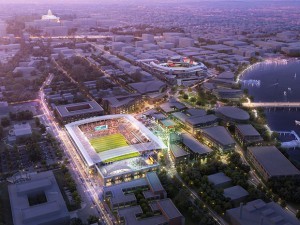Mayor Gray’s updated deal for a DC United soccer stadium makes progress toward ensuring that the city and team share the costs fairly, but it still could leave the District paying half or more of the total. The deal creates risks for the city while enabling the team owners to benefit financially from both the new stadium and development around the stadium that they would control.
A new stadium for DC United would add to the quality of life in our region, and some level of support from the District is likely to be needed, as is the case with most professional sports stadiums. But the District should approach the deal in a responsible way.
DCFPI’s review of the finances of the deal reveals positive developments but also important lingering concerns. Many details are included in legislation submitted to the Council, but other details are part of documents the mayor has not shared, such as a ground lease.
- Some city costs would be capped, but not all: The deal sets caps the city’s cost to acquire stadium land at $90 million, but DC would pay all the costs — with no cap — to get the land ready: demolition, environmental cleanup, and new infrastructure. The Gray administration has not shared estimates, but the costs could be $30 million to $50 million or more.
- New revenues to help offset costs, but not for 10 years: DC United would pay the District $2 per ticket, starting in year 11 of the stadium’s operation. This could bring in $1 million per year, which would offset a small share of the city’s costs. (This fee is mentioned in a press release from Mayor Gray, but is not included in legislation submitted to the Council.)
- Substantial tax breaks: The team’s owners would pay no property taxes for five years, and partial taxes for the next 15 years. The team also would not have to collect sales taxes for five years on tickets, food or drink, or merchandise within the stadium or on the adjacent land. Full sales taxes would not have to be collected until the 11th year. According to the Washington Post, this could cost the District about $40 million.
This means that the costs to the District could easily exceed more than half of the estimated $300 million total stadium costs, and the District would face all of the risk if the costs of preparing the land rise. That doesn’t seem like a fair deal, given the team owners’ strong financial interest in a new stadium. A better approach would cap the District’s costs and ask the team to pay a majority of the stadium costs.
Over the next weeks, the District’s Dime will look at other aspects of the updated deal, including plans for a land swap involving the Reeves Center, local hiring requirements, and the need for a community benefits agreement with stadium neighbors.
To print a copy of today’s blog, click here.

